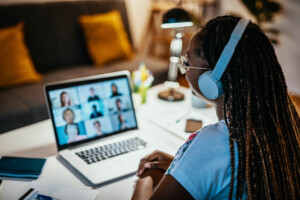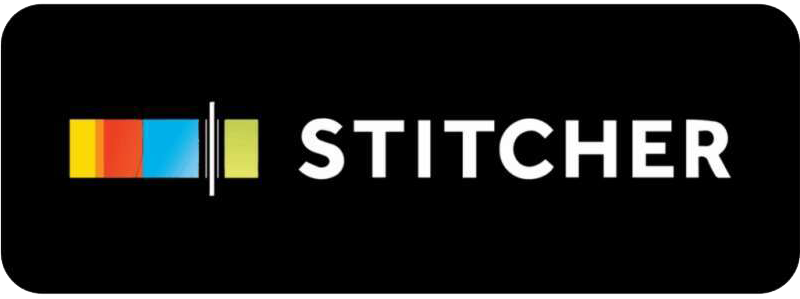December 14, 2021
Listen on:
Best Practices for Virtual Training

Woman in virtual training
Mike Merrill talks with Kenning Partner Jerry Stauduhar about what Kenning has learned over the past year or so about best practices for virtual training. Jerry talks about how Kenning adapted to the new Zoom realities, and some of the major lessons they learned in the process: Deliver your content in small bites; mix up the modalities you work in; and lean into the performance, especially with your voice. Jerry finishes up by explaining some of the benefits to virtual training, and explores the future of the virtual and hybrid training models.
Listen
Authors:
Related Articles:
Transcript:
Mike Merrill: I’m Mike Merrill. I’m here today with Kenning Associates partner, Jerry Stauduhar.
Jerry Stauduhar: Hey, Mike.
Mike: Jerry, I know Kenning’s learned a lot about virtual training over the past year, and we’re here to impart some of that hard-earned wisdom. I think we have some general ideas of how you can make a training better and some tactics as well.
Jerry: Yeah, well, we definitely through necessity have learned a lot about virtual training and making it work. I think we’ve developed some good perspectives around what leads to successful virtual training.
Mike: Can you maybe give us a little bit of an inventory of the kinds of training you were doing prior to, say COVID?
Jerry: We have a number of kind of standard offerings; they’re always customized to an extent for clients, but a couple of the big ones that we get a lot of interest in is one. We call strategic communications, which is really around how do you develop clear, concise business-oriented perspectives that share a point of view succinctly and clearly to an audience. Often senior audiences.
And the other one is, balcony conversations. And that one’s really about helping people understand other people’s perspectives. And using that as a tool to have better relationships to solve problems at a deeper level to resolve conflict and all kinds of different ways that you can use the balcony conversations to improve your relationships at work.
Mike: It seems like these offerings relied greatly upon the in-person experience, where you’re actually talking directly to people.
Jerry: Well, we always thought so for sure. With the strategic communications, which we’ll call “Strat Comms”, that was often a one-day program. That was the original design. We would come in and work with the group, usually around 12 people in a live setting. And it would be a full day workshop with lots of slides and some lectures and exercises built in throughout the whole day, so that’s one model.
And others might be full-day or multi-day programs in person. But for the balcony conversations, that always involved a lot of role-plays, videotaping playback, a lot of different things going on in that workshop. And that’s actually one of the things we found with that particular one where the virtual setting almost ended up working to our advantage, because it was actually easier to capture video, but it did also kind of necessitate us spreading it out over a multi-day format as well.
Mike: So prior to COVID arriving on our shores, early in 2020, you had these workshops, they were mainly done in person and then you have this challenge. And so how did you face the challenge?
Jerry: We went back to the drawing board in some ways, faculty involved and just talked about, okay, this is the new reality what does this look like? I think everybody, once lockdown started and so many of us started doing virtual conferences, whether that zoom or any other platform, we quickly came to realize it’s just really not any fun or hardly sustainable to try and take a full day workshop and just do it virtually. It’s just too long in one day. It’s difficult for faculty on one hand to sustain energy, but also for participants to maintain their focus. To not get bored, to not get distracted.
We just felt that if we could break it into multiple modules and multiple days, that was just going to work better for everyone. People get a chance to absorb what they’re learning and even start to think about and put it a little bit into practice before taking in new information. So it’s less of a, you know, firehose kind of situation.
Mike: You were able to successfully translate these two workshops, the stratcoms and the balcony conversations into a forum. What was your dominant platform for this?
Jerry: We’ve mostly used Zoom.
Mike: That’s something I think people all over the world, millions and millions of people, have found themselves moving from maybe largely in-person sometimes on the phone, sometimes email and moving to zoom. This has been an enormous worldwide shift amongst knowledge workers.
Jerry: Absolutely.
Mike: I believe that in the course of making this kind of translation from in-person to zoom you learn some very particular things, and you solve some very particular problems, and that our listeners might be able to learn from that.
Jerry: Yes, indeed. Three big things that we consider takeaways from our experience that we try to bear in mind as we continue to evolve our offerings. And again, we do a lot of custom work, so it’s not just our standard programs, but how do we translate this into all of the training that we need to do these days? Because it’s virtual. Our top three things.
I would say, number one is you want to deliver your content in small bites to really allow for mental breaks and reflection. And that’s both for participants and for faculty.
Number two, you want to mix up the modalities a lot. You can’t stick with just slides and just lecture. You got to try every trick in the book to try and keep the participants engaged in learning.
And then finally, number three is leaning into the performance when presenting virtually, as I like to say, “Sing out Louise”. And that’s a reference from the musical, Gypsy. Because attention spans are short and because the visuals are cluttered in Zoom or any other virtual platform, and chances are people are multitasking and have multiple windows open, your best bet is using your voice to keep people’s attention.
Mike: Let’s start with that first one, deliver content in small bites. I think you said to allow for that mental breaks and reflection by both the participants and workshop leaders. Why is that important?
Jerry: Breaking things into small bites, I think is important because the attention spans are so short these days and only getting shorter. Along with that, Zoom–or any virtual platform–is really just an exhausting medium. It takes a lot of concentration as a listener to pay attention and to actually learn from what’s going on. And it takes a lot of energy as a presenter and as a facilitator to keep that energy up as well.
So we’ve just found that breaking larger pieces of content, what might’ve been a full day workshop into like three different modules, that could happen in three days, right after another, or you could even break it up across weeks, which we have found out has worked out really nicely for some groups because they take a little bit of, information in, they get to process it, maybe work with it a little bit on the job, and then they’re ready to get some more learning.
And we’ve actually just found that the learning has really deepened, and we get very high satisfaction from the participants and also then hear from the leaders who have brought us in that, “Wow, we’re really seeing a difference here.”
Mike: So, we hear from the participants that they’re happy with the workshops and they appreciate the time to kind of imbibe it and practice it and get deeper into it. And how about the workshop leaders? How are they responding?
Jerry: As a workshop leader, it’s nice to have that time to reflect about how things went, how things felt, how the group seemed to be responding to the material where you left the discussion, et cetera–and then have a chance to make adjustments for the next session. If the group seemed to be moving really quickly, that gives you an option to think about how you would adjust for that. Or, similarly, if the group really seems to be struggling with the concepts, how do you make it more accessible to their particular needs?
Mike: So that is deliver the content in small bites. And I think the second one is you suggested that, people mixed modalities.
Jerry: Absolutely. I think it’s important to mix up the modalities in the virtual world. It’s always important in training period, but it’s just all the more amplified in the virtual world. Certainly, I think anybody who has done any training, adult learning, and study in that field knows you can’t just lecture at adults and then hope that they’re going to absorb a whole lot of it. We know that different people absorb content in a lot of different ways, so mixing up the modalities is important.
On the virtual platforms, of course, you’re going to need to do a little bit of lecturing and sharing of raw concepts, but then we want to move as quickly as possible to some other kind of mode, whether that’s going into a breakout discussion or a breakout exercise or some other kind of virtual thing, like a survey, or generating a word cloud together. All of these things that can keep people interested in the topic and stimulate their learning and their brains and their interest.
Mike: After we broke out into these various groups, do you recommend everyone come back together for a summation of the thoughts of the workshop?
Jerry: It really varies. But typically, yes, I would say if we start a group together, we want to end them together if we can do that. So pulling everybody back together for a final debrief.
And because learning is going on in those breakout sessions, everybody’s going through a similar experience, but maybe getting different takeaways, we want to make sure we’re always like cross-pollinating the groups when they come back together. So everybody has a chance to learn from everybody’s experience as much as possible.
Mike: Do you find this is an effective strategy? Are you hearing from the participants that they’re learning more?
Jerry: Yes, we do. We get great feedback on these virtual programs in that people say they like, first of all, the different modalities, they liked the fact that it’s been spread out across time and that they feel like they’ve had a guided, supported journey versus like again, having a firehose shout at them one day and then going back to the job and trying to make the best of it.
Mike: So that is mixing modalities. I believe your third tactic is to lean into the performance always when you’re presenting, but especially when you’re presenting virtually.
Jerry: Yes, absolutely important to lean into the performance. And I would say the vocal is the number one thing. Now there’s been a lot of studies over the years that have tried to kind of measure the impact of a live presenter and they all come around to the conclusion that a little bit more than half of the impact is actually from the visuals that your audience is seeing, your body language, your facial expressions, all of that. They’re actually picking up a lot of information from that. And then at around 40% or so is the vocal delivery, the tone of voice, the impact you’re making with your role. And then surprisingly, a little less than 10% of the impact of a live presenter comes from the actual content itself, the raw message.
So we always say, of course, in our workshops, it doesn’t mean that your content, your message is not important because of course. It’s critical in business and that’s probably why you’re being hired, but it does go to say that when you deliver a message live, there’s a lot of opportunity to either support that or detract from that, with what you’re doing visually and vocally.
We know on Zoom that the visual aspect is really very distorted and very limited. All of those physical clues that we’re used to picking up from one another, even subconsciously, when we’re in the same room together, are all but lost. So with the visual impact being so diminished, it only stands to reason that the vocal needs to do even more to keep people’s attention. It’s important to just mix up your vocal tactics, because research has shown that it keeps your audiences’ brain from flat lining basically.
Mike: If I want to use my voice as a better tool for these virtual settings, how do I do that?
Jerry: Well, you want to use the full range of your voice. You want to think about tone. Are you going high? Are you going low? Rate of delivery, emphasis on particular words, all of those kinds of things, but the more variety that you throw in the more your audience’s brain is just going to be kept on its toes.
If you kind of go into a monotone or any kind of level of saying this for too long, the brainwaves and your audiences’ head are going to kind of go in that even pattern too and it start to wander off and say, oh, I kind of get what’s going on here, I can use some of this capacity for something else. But if you’re constantly mixing things up well, then I’m going to have to stay more attuned. I don’t mean to say that you should get silly about it, but you probably can do a lot more than you think you can.
Mike: We’ve talked about some of the ways that Kenning has made virtual trainings better. Are there benefits just to virtual trainings in general?
Jerry: I think so. One of them that comes to mind first off is we work more and more with teams that are dispersed across the world. Even if a company has a strong presence in one geography, very often, there’s still team members in Asia, in Europe, across the world. Obviously not having to pull people together, physically, for a training session has a lot of advantages. Even if you were to do that and pull a globally dispersed team together at one time, you’re going to feel compelled to really make sure it’s big and comprehensive and probably takes a couple of days and blah, blah, blah, to make it worth the effort and the time and the expense.
But with virtual stuff, you can just say, you know what, if we just need a half day on a particular topic to get this team over its next hurdle. That’s great. You can do that relatively easy virtually. It does mean that sometimes as a facilitator, I’m starting a session at 8:00 PM or 6:00 AM, but I guess that makes up for not having to hop on so many airplanes.
Mike: Going forward, as we hope COVID recedes, do you expect that Kenning will return to its previous regimen of providing all these workshops all over the world? Or do you think that virtual will continue to play a role.
Jerry: I think virtual will continue to play a huge role. One of the reasons being what I just said about teams being dispersed and, even prior to COVID, harder and harder to pull people together for full days of training. So if you can break it up and you don’t all have to come together, then it creates a lot more possibilities.
That said, I know that some of my clients look to have a training event as a way sometimes to pull teams together and to give them an opportunity to have a live interaction. So, the training is built into maybe a larger event or an offsite. And this is going to be important, I think, as we come out of lockdowns, people may be returning to offices. Then I see this is an opportunity to have a meaningful pulling together of teams and a reassembly of folks who have probably been virtually dispersed for many, many months.
Mike: A great opportunity to convene. Do you see a role for hybrid programs that are maybe largely delivered in person, but have a virtual element?
Jerry: Absolutely. Very often we will have some pre-learning for people in a workshop so they can do that virtually, maybe they’re going to have an exercise. They’re going to need to look at a video, that kind of stuff, as a way to preview the learning. Then we come together for a workshop for a day or two, whatever it might be. And then, afterwards, to complete the learning experience, we’ll have up coaching with each of the participants and help them sort of, you know, just in time on the job basis, try to put the new skills into practice on their job and get guided support for that.
We’re a really big believer in that model. We don’t like to just dump training on people and then hope they get it. We’d rather be able to stick around and help them really make the change that the organization was shooting for to begin with.
Mike: I wondered if what we’re seeing here a little bit also spaced learning, Jerry, where it’s better to learn something originally and then have it reinforced at some later period.
Jerry: Absolutely. Again, we like to extend our engagement with any group of learners in any way that we can. The old model did lock us in a little bit more feeling like, well, it had to be live and therefore it’s going to happen just for convenience sake, in one big chunk. Whether that’s one solid day or a couple of days together, whatever it might be.
And this notion of having extended learning, virtually particularly follow up coaching and other models, just didn’t come into play as much. And now that’s very much become a part of our total program package when we’re proposing to clients.
Mike: Jerry, if someone was interested in Kenning’s virtual trainings, how could they contact you?
Jerry: People can reach us by going to our website, kenningassociates.com. And then if you go to the contact button up at the top, or even any of the partner’s bio pages you have an opportunity to reach out with a quick email and let us know you’d like one of us to reach out to you to start a conversation.
Mike: Jerry, I think this was very enlightening. I think the tactics that you provided should be useful to our listeners. Any last thoughts?
Jerry: Yeah, we have really come to appreciate and enjoy virtual training where we were a little afraid of it at first, but now that we’ve been forced to dive in and develop a track record on it, we really see the advantages of it. We encourage people to just get out there and give it a try. People need their training, even though we’ve been in lockdown, it’s a good way to do it.
Mike: Well, thank you, Jerry. Thanks for your time today.
Jerry: My pleasure, Mike.







